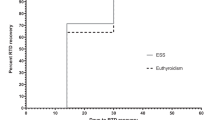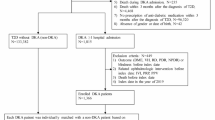Abstract
Summary: Twenty-five cases of acute ketoacidosis, occurring in insulin-treated diabetic children in previous good health, were studied close to the onset of illness and throughout the first 24 hr of therapy. In most patients, symptoms of illness and ketonuria had been present for less than 12 hr; in 9 subjects, they had been present for less than 4 hr. Initial plasma glucose concentrations ranged from 252 to 849 mg/dl. The first pH values in 21 cases were less than 7.27, and in the remaining 4 studies, the CO2 was less than 14 mEq/liter. Identifiable sources of stress, such as infections or emotional arousal, preceded the development of ketoacidosis in 20 cases.
Serial measurements were made of plasma glucocorticoid, growth hormone, and glucagon concentrations as well as urinary excretion of epinephrine and norepinephrine to assess the role of these hormones in acute ketoacidosis and to evaluate their relationship to the abnormalities in glucose and electrolyte homeostasis. Excessive urinary excretion of epinephrine was a frequent and striking phenomenon. Output was greater than 4 S.D. above the mean in 20 of 23 cases in the first 2 hr of the study. In 15 cases, the values fell into the normal range by approximately 14.5 hr, but in seven patients, epinephrine overproduction persisted for the entire study. Cortisol hypersecretion was present in 24 of 25 patients and persisted for 6 to 8 hr or longer before gradually subsiding. Initial growth hormone concentrations were elevated in seven patients (20 ng/ml or above), but the highest values (20 to 160 ng/ml) were observed after insulin administration. At the outset, plasma glucagon concentrations were less than 200 pg/ml in 11 patients; in 11 others, it ranged between 250 and 1250 pg/ml. The elevated values usually were transient. Of 22 cases in whom all five hormones were measured at the start of the study, 21 exhibited increased production of at least three of the stress hormones.
We conclude that some diabetic children who have received their usual dose of insulin develop hyperglycemia, dehydration, and acidosis within a few hr of experiencing stress because large amounts of counterregulatory hormones, especially catecholamines and cortisol, are released.
Speculation: Acute onset of ketoacidosis in previously healthy insulin-treated diabetic children occurs because their daily dose of insulin is insufficient to offset the effects of the counterregulatory hormones produced in response to stress (catecholamines, cortisol, glucagon, and growth hormone). Hyperglycemia, dehydration, and acidosis result from the glycogenolytic, lipolytic, and ketogenic action of the stress hormones.
Similar content being viewed by others
Log in or create a free account to read this content
Gain free access to this article, as well as selected content from this journal and more on nature.com
or
Author information
Authors and Affiliations
Rights and permissions
About this article
Cite this article
MacGillivray, M., Bruck, E. & Voorhess, M. Acute Diabetic Ketoacidosis in Children: Role of the Stress Hormones. Pediatr Res 15, 99–106 (1981). https://doi.org/10.1203/00006450-198102000-00002
Issue date:
DOI: https://doi.org/10.1203/00006450-198102000-00002
Keywords
This article is cited by
-
Management of Diabetic Ketoacidosis in Children and Adolescents with Type 1 Diabetes Mellitus
Pediatric Drugs (2020)
-
Diabetic ketoacidosis
The Indian Journal of Pediatrics (1986)
-
Emotional stress and diabetic control: A postulated model for the effect of emotional distress upon intermediary metabolism in the diabetic
Biofeedback and Self-Regulation (1985)
-
Diabetic control in children and adolescents: Psychosocial factors and therapeutic efficacy
Journal of Youth and Adolescence (1983)



